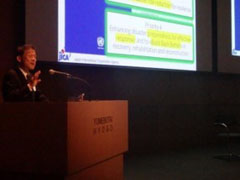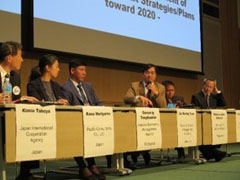October 31, 2018
On October 30 to 31, 2018, the Asian Conference on Disaster Reduction (ACDR) 2018 was held in Awaji City, Hyogo Prefecture, Japan, to commemorate the 20th anniversary of the Asian Disaster Reduction Center. More than 100 delegates from more than 25 member and partner countries took part, and four sessions and two side events were held. One of the side events sponsored by JICA, discussed the efforts, problems and future policies in each country on the premise of achieving the Global Target (e), i.e., "Substantially increase the number of countries with national and local disaster risk reduction strategies by 2020.". This event was carried out with five speakers, and Mr. Kimio Takeya, Distinguished Technical Adviser to the President of JICA, was the moderator.

Presentation by Mr. Kimio Takeya, Distinguished Technical Adviser to the President of JICA.
Ms. Moriyama from Pacific Consultants Co., Ltd., the first speaker, introduced the DRAD2 (Disaster Risk Reduction Investment Accounts for Development) model developed in house with the theme of appropriate pre disaster investment for disaster risk reduction (DRR). JICA and Kyoto University were also involved in the development of the initial model. Based on the premise that the appropriate pre disaster investment level changes depending on the situation in each country, the optimal pre disaster investment level can be evaluated by simulation using DRAD2. Ms. Moriyama said that she would like to increase the number of cases and to develop them in the future.
Dr. Ganzorig from the National Emergency Management Agency (NEMA) of Mongolia, Dr. Tuan from the Vietnam Disaster Management Authority (VDMA), and Dr. Marluo from the Office of Civil Defense (OCD) of the Philippines presented the situation of disaster and the efforts on the development of local DRR plans in their home countries. Dr. Ganzorig mentioned that Mongolia gives emphasis on the implementation of the "Sendai Framework for Disaster Risk Reduction" and the establishment of a community participation type of a national DRR program, although there are shortages in budget and human resources and political instability. Dr. Ganzorig also emphasized that Mongolia will continue solving such problems, while Dr. Tuan mentioned that Vietnam has prepared a road map in the field of DRR and is implementing the six (6) priority programs set forth in the road map currently focusing on the development of a local DRR plan. Dr. Tuan further emphasized that there are many issues involved, such as leadership, capacity and budgeting.
On the other hand, Dr. Marlou narrated, firstly, on the efforts and issues regarding the local DRR plan in the case study for Luzon Island in the Philippines, and the different activities such as the introduction of early warning system, the strengthening of local disaster risk management organizations, and the budgeting for such activities. Dr. Marlou also emphasized, as a future policy, the mainstreaming of Disaster Risk Reduction and Management (DRRM) in developing local DRR plans and the promotion of community level awareness and independence.
Lastly, Mr. Kato from the Earth System Science Co., Ltd. of Japan narrated case studies of JICA's projects regarding the development of DRR plans on the basis of examples implemented in Vietnam, Ecuador and Sri Lanka, including the support for the revision of local DRR plans and the importance of pre disaster investment concepts. Some participants commented on the difficulty of developing a local DRR, and there were some comments asking for support from JICA.

Panel discussions.
After each speaker's presentation, a panel discussion was held. In promoting local DRR plans, the participants asked the opinion of each speaker on the challenges and issues in the speaker's country and the case studies of good practice in the country. In the panel discussions, many opinions focused on how to tackle the issues.
Finally, the JICA's representative emphasized that achieving the Global Target (e) is not an easy task, and all participants, not only the donors, but also the country participants, agreed that each country should tackle such tasks independently.
Through this event, all the participants, including the speakers, were once again reminded about the importance of achieving the Sendai Framework for Disaster Risk Reduction's Global Target (e)" and the necessity of achieving the target.




scroll